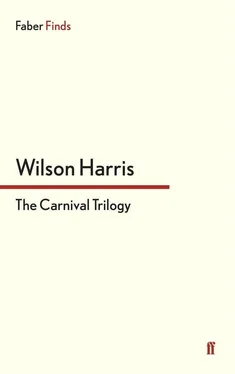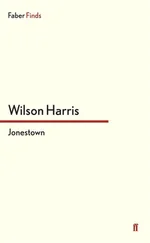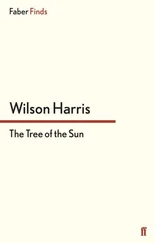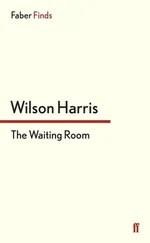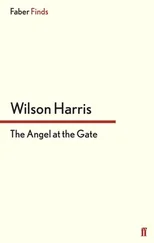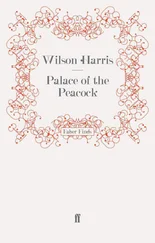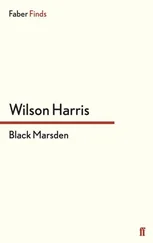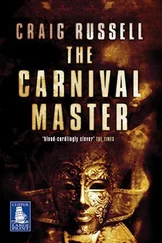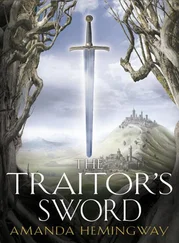I had sculpted the king of thieves that morning from the stump of a felled tree. But now it was as if within the cloak of processional rock in the Waterfall he had eaten of the pooled stars in the Macusi river of drought. Sculpted wood then became unclothed rock, rock visionary flesh and blood in the creation of ‘live absence’ into ‘presence’ upon the first bank of the river of space.
He led the procession up the hill past the El Dorado Mission House. He stood at the head of the grave on the hillside. The corpse of the dancer was laid to rest. I saw Robot’s eyes fixed there. Each detail confirmed his concept of arrested being. None would escape their fate. And that fate was the power of the grave, the power of the prisonhouse, the toleration of a measure of fantasy in chained millions and millions who stood in a long but inevitable queue around the globe awaiting their turn to bury their dead or to be buried by those they hate, fear or even love, to kill or to be killed in a battle, on the street, in the air, on land or water. It was the abyss within those who bury and those who are buried, those who kill and are killed, that divided the Inspector and me: the subtle abyss of an incalculable, inner reformation.
The king of thieves had brought with him a cup of the diagrammatic pooled stars in or under the drought-body of the Macusi/Potaro River. He poured it now over the dancer. It was shining rain. The survival of humanity. The survival of the river of space. It was as if in so doing he released for an instant the heavy burden of gold he had stolen across the centuries, the heavy obsession that tormented him and his fellow miners whom he led. He became the last tormented thief in the world in that miraculous instant. He was eternally alive in that instant. Vital time, newborn time. A curious reformation of the instant heart within the subtle abyss that lies within those who bury and those who are buried.
THE SECOND BANK (Carnival Heir of Civilizations)
Blessed are the poor in spirit: for theirs is the kingdom of heaven.
Matthew 5:7
In 1933 I was ‘green and carefree’, I still thought quality and merit, however hardly achieved, the only yardstick. I had yet to hear of Bartók dying, impoverished and forlorn in some foreign field; of Berg whose life might have been spared if he could have afforded a specialist; of Webern, with works known to a handful …; of Schoenberg’s death, aged seventy-seven, worth £100.
from A Goldfish Bowl, Elisabeth Lutyens (Cassell, 1972)
The voices of Macusi children returned to me across the years as I retraced my steps past the grave on the hillside and into the El Dorado Mission House. There were twelve children in the choir Penelope assembled in 1948, seven to eight years old, three of whom were drowned in the Potaro/Macusi tapestry of waters in 1950.
I hear them now. I see them in a loom that Penelope weaves. I hear their faint voices in the deep interior. It is as if the voice of the dancer sings through the soil of his grave. Sings within the voices of the three drowned children I have sculpted into a flute.
Music possesses such solidity one may hold it in one’s mind, sculpt it into a mysterious flute, a flute that is akin to a spiral or a curious ladder that runs into space.
‘Yes,’ I said to Penelope, ‘a living language is a precious ladder, it’s the antiphon of the flute in which the dead and the living discourse in the heights and the depths. Listen to the voices of the drowned children. They live again within solid music and within the elusive story they tell. They brush past my ears as if the dancer in the grave on the hillside hears the rhythm of the pooled stars that the king of thieves tilted upon him. That tilt is important. You shall see. That tilt tells of a ladder.’
I knelt on the ground and meditated upon a grain of dust as light as a feather.
‘The flute sings of an ancient riverbed one hundred fathoms deep, far below the Potaro River that runs to the Waterfall. Two rivers then. The visible Potaro runs to the Waterfall. The invisible stream of the river of the dead runs far below, far under our knees. The flute tells of the passage of the drowned into the river of the dead. The flute tells that the river of the dead and the river of the living are one quantum stream possessed of four banks. We shall see!
‘So deep, so far below, is the river of the dead that the sound of its stream may never be heard or visualized except when we clothe ourselves with the mask, with the ears of the dancer in the hill. Then the murmur of the buried stream comes up to us as if its source lies in the stars and it may only be heard when we are abnormally attentive to the mystery of creation and the voice of the flute within the lips of three drowned children.
‘Listen to the voice of the flute. It sings and tells its tale in the English language yet solid (however whispering) music gives the Word that echoes in one’s frame as one kneels uncanny twists, uncanny spirals, that relate to ancestral tongues, Macusi, Carib, Arawak, Wapishana pre-Columbian tongues that have been eclipsed.
‘From such eclipse emerges the rich spoil and upheaval of the Word, upheaval into banks of the river of space. As though the flute is a paradox, it arrives at the solidity of music by processes of excavation within a living language.
‘One cannot tame the voices of the flute, voices of such uncanny lightness yet miracle of being that they are able to tilt the two rivers, the visible and the invisible rivers, into diagrammatic discourse; and in so doing to create the four banks of the river of space into a ladder upon which the curved music of the flute ascends. Those banks are dislodged upwards into rungs in the ladder and into stepping stones into original space.
‘The tilted banks convert the river of space into a sieve that spills its contents. That sieve is the antiphon of the Waterfall, it constitutes a discourse between the rocks in the Waterfall and the clouds in the sky. The spilt water evaporates into cloud, evaporates into the promise of new rain, into cloudkinship to latencies of precipitation in and of the Waterfall through rock. And the voice of the spiralling flute mirrors within solid music the ascension of the spirits of the living and the dead through rock and cloud into space.’
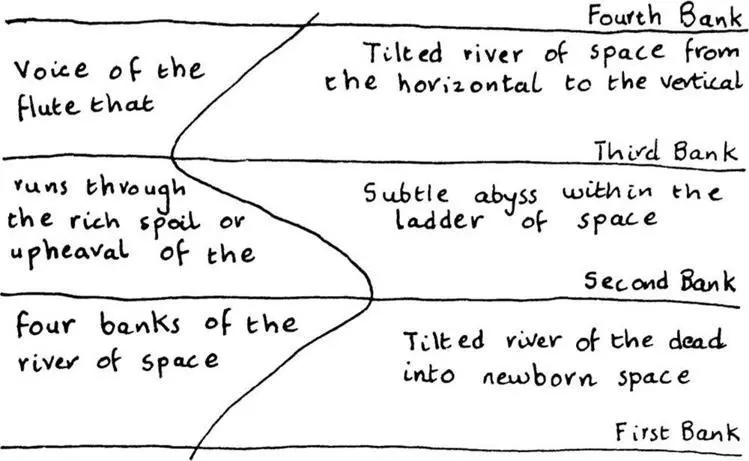
It was in this way through abnormal care and attention, by donning the mask and the ears of the dancer, that Penelope, Ross and I were able to follow the spiral of the flute upwards from the first bank to the second bank of the river of space.
Equally through his masked and bandaged eyes in the hill where he lay (half-artifice, half-Christian mound of gnosis) we gained a perception of the crumbling yet renascent spirit — evaporative, precipitative — of the tapestry of the Macusi/Potaro overground/underground rivers dislodged now into a visionary and wide ladder within and beyond our dreams.
Proof of the reality of the curvature of the music that rose upon the ladder of space from rung to rung lay in my work as an engineer in the 1940s and 1950s when I gauged the Potaro/Macusi River for hydro-electric power potential. Electricity culled from the dark waters by harnessing and building upon the architecture of the Macusi Waterfall was a vital ingredient in contemplating a new settlement for refugees in the wake of the Second World War. Nothing was to come of it but though I remained unconscious of a metamorphosis at the time my life had changed in its innermost fabric when I met Canaima and his team of victims and spiritual refugees. The truth was (I had long suppressed the knowledge in myself) I had known Canaima long before we ‘first’ met on the bank of the Potaro River in 1945. As I retrace my steps now in this book of dreams I hear the music and the footsteps of generations upon the ladder of science and spirit as if for the first time, the first truly attentive ear I place to the ground and to the body of the turning globe.
Читать дальше
